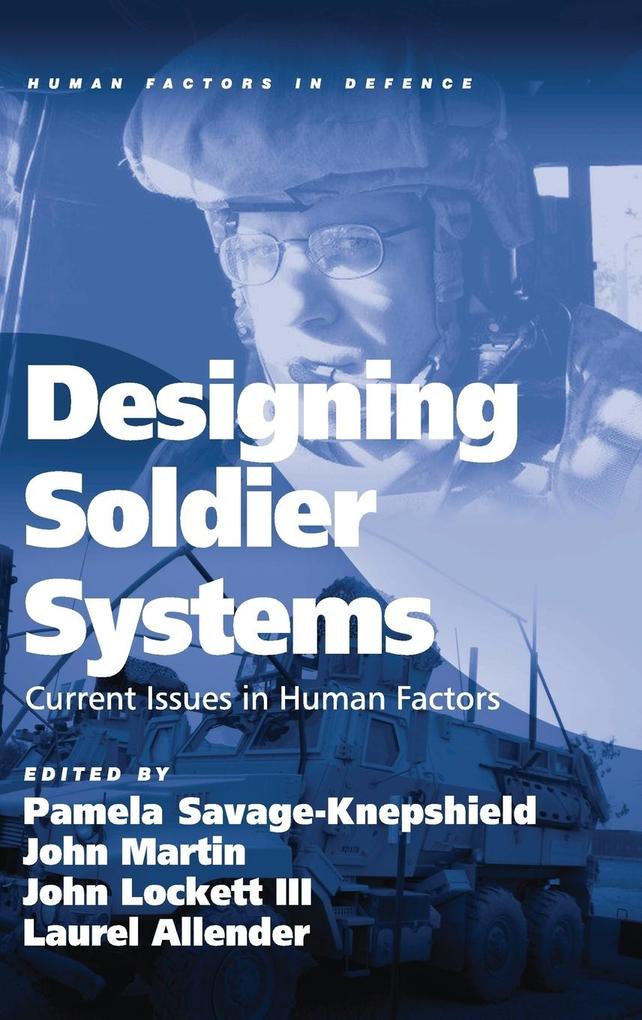Bücher versandkostenfrei*100 Tage RückgaberechtAbholung in der Wunschfiliale
10% Rabatt10 auf Tonieboxen, Figuren & Zubehör mit dem Gutscheincode: TONIE10
Jetzt einlösen
mehr erfahren
Zustellung: Mi, 26.03. - Sa, 29.03.
Versand in 1-2 Wochen
VersandkostenfreiBestellen & in Filiale abholen:
This book focuses on contemporary human factors issues within the design of soldier systems and describes how they are currently being investigated and addressed by the U. S. Army to enhance soldier performance and effectiveness. Designing Soldier Systems approaches human factors issues from three main perspectives. In the first section, Chapters 1-5 focus on complexity introduced by technology, its impact on human performance, and how issues are being addressed to reduce cognitive workload. In the second section, Chapters 6-10 concentrate on obstacles imposed by operational and environmental conditions on the battlefield and how they are being mitigated through the use of technology. The third section, Chapters 11-21, is dedicated to system design and evaluation including the tools, techniques and technologies used by researchers who design soldier systems to overcome human physical and cognitive performance limitations as well as the obstacles imposed by environmental and operations conditions that are encountered by soldiers. The book will appeal to an international multidisciplinary audience interested in the design and development of systems for military use, including defense contractors, program management offices, human factors engineers, human system integrators, system engineers, and computer scientists. Relevant programs of study include those in human factors, cognitive science, neuroscience, neuroergonomics, psychology, training and education, and engineering.
Inhaltsverzeichnis
Contents: Preface; Part I Understanding Human Performance with Complex Systems: Human performance challenges for the Future Force: lessons from Patriot after the second Gulf War, John K. Hawley and Anna L. Mares; Who needs an operator, when the robot is autonomous? The challenges and advantages of robots as team members, Keryl A. Cosenzo and Michael J. Barnes; Effects of operators' spatial ability on their performance of target detection and robotics tasks, Jessie Y.C. Chen; Reducing workload: a multisensory approach, Linda R. Elliott and Elizabeth S. Redden; Tactile displays in army operational environments, Timothy L. White, Andrea S. Krausman and Ellen C. Haas. Part II Overcoming Operational and Environmental Conditions: Operations on the move: vehicle movement and soldier performance, Richard A. Tauson; Night vision goggle design: overcoming the obstacle of darkness on the ground, Elizabeth S. Redden and Linda R. Elliott; The effects of encapsulation on dismounted warrior performance, Lamar Garrett, Debbie Patton and Linda Mullins; Soldier auditory situation awareness: the effects of hearing protection, communications headsets, and headgear, James E. Melzer, Angelique A. Scharine and Bruce E. Amrein; Human factors in military learning environments, Valerie J. Berg Rice and Petra E. Alfred. Part III Assessing and Designing Systems: The multi-aspect measurement approach: rationale, technologies, tools, and challenges for systems design, Kelvin S. Oie, Stephen Gordon and Kaleb McDowell; Future Soldier-system design concepts: brain-computer interaction technologies, Brent Lance, Jorge Capo and Kaleb McDowell; Soldier-centred design and evaluation techniques, Pamela A. Savage-Knepshield; Addressing and resolving science and technology capability gaps identified by warfighters in Iraq and Afghanistan, Raymond M. Bateman, Charles L. Hernandez and Frank Morelli; Immersive simulations for dismounted soldier research, Kathy L. Kehring; Tactical ergonomics: applying man
Produktdetails
Erscheinungsdatum
18. Dezember 2012
Sprache
englisch
Seitenanzahl
504
Herausgegeben von
Pamela Savage-Knepshield, John Martin, Laurel Allender
Verlag/Hersteller
Produktart
gebunden
Gewicht
916 g
Größe (L/B/H)
240/161/31 mm
ISBN
9781409407775
Entdecken Sie mehr
Bewertungen
0 Bewertungen
Es wurden noch keine Bewertungen abgegeben. Schreiben Sie die erste Bewertung zu "Designing Soldier Systems" und helfen Sie damit anderen bei der Kaufentscheidung.









